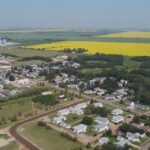The sun beat down mercilessly on northern Manitoba this weekend as firefighters achieved a critical victory against a threatening wildfire that had edged perilously close to the mining community of Flin Flon, located approximately 630 kilometers northwest of Winnipeg.
Provincial wildfire officials confirmed Sunday that the blaze, which ignited late Friday afternoon and rapidly expanded to consume over 200 hectares of boreal forest, has now been successfully contained. The fire initially prompted significant concern as it approached within five kilometers of Flin Flon’s eastern outskirts, triggering emergency response protocols across the region.
“We’ve established effective control lines through a combination of aerial suppression tactics and ground crews working around the clock,” said Miranda Thorpe, Manitoba Wildfire Service’s regional coordinator. “The immediate threat to Flin Flon has been neutralized, though we remain vigilant given the continuing unfavorable weather conditions.”
The containment success comes amid a concerning meteorological outlook for Manitoba’s northern regions. Environment Canada has extended its heat warning for the area, with temperatures expected to remain above 30 degrees Celsius through midweek, accompanied by relative humidity levels below 25 percent—conditions that significantly elevate wildfire risk.
According to Canada’s wildfire monitoring data, Manitoba has already recorded 63 wildfires this season, approximately 40 percent above the five-year average for early June. The situation mirrors broader national trends, with experts at CO24 News reporting that Canada faces another potentially record-breaking wildfire season following 2023’s unprecedented destruction.
Flin Flon Mayor Colleen McKee expressed both relief and ongoing concern during an emergency management briefing. “While we’re grateful for the tremendous work by our firefighting teams, we recognize we’re just entering what could be an extremely challenging summer,” McKee stated. “Our emergency operations center remains activated, and we’re urging residents to maintain preparedness.”
Provincial political leaders have responded by mobilizing additional resources to northern regions. The Manitoba government announced the deployment of five additional water bombers to strategic locations across the north, supplementing existing aerial firefighting capacity.
The economic implications remain significant for Flin Flon, a community historically dependent on mining operations. Representatives from Hudbay Minerals confirmed that while operations continue normally, contingency plans are in place should the wildfire situation deteriorate. The potential disruption highlights the business vulnerabilities faced by resource-dependent northern communities during intensifying wildfire seasons.
Climate scientists at the University of Manitoba have identified a troubling pattern of earlier wildfire seasons and increasingly extreme fire behavior across the province. “What we’re witnessing aligns with projected climate change impacts for the boreal region,” explained Dr. Helen Waring, climatologist at the university’s Environmental Research Center. “The combination of earlier spring thaws, reduced winter precipitation, and more frequent heat domes creates ideal conditions for wildfire propagation.”
For Flin Flon’s 5,800 residents, the successful containment provides temporary reassurance, but the community remains on edge. Local authorities maintain an evacuation alert status, with emergency shelters prepared in neighboring communities should conditions rapidly deteriorate.
As Canada faces what may become another historic wildfire season, the critical question emerges: how will northern communities adapt to what increasingly appears to be not an anomaly, but rather the new normal of intensified fire regimes driven by our changing climate?

























